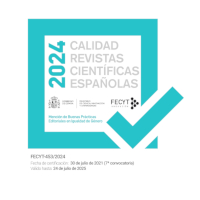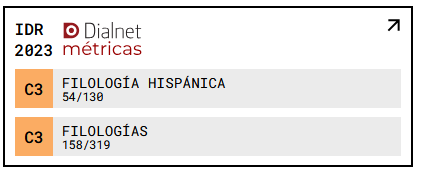Le genre inclusif
un regard grammatical
DOI :
https://doi.org/10.18172/cif.5292Mots-clés :
genre, langage inclusif, syntaxe, morphologie, classificateursRésumé
Ces dernières années, un nouveau marqueur de genre est apparu en espagnol, identifié comme inclusif. Ce marqueur donne lieu à des noms avec trois formes de genre –niño, niña, niñe–. L'objectif de ce travail est d'éloigner cette question des considérations politiques ou sociales et d'examiner les caractéristiques grammaticales internes de cette nouvelle forme comme moyen d'encadrer tout débat social sur le phénomène, qui devrait se poser après l'analyse de ses conditions linguistiques internes. Les résultats montrent que, contre certaines critiques qui ont été soulevées, le genre inclusif n'implique pas de rupture avec les règles de l'espagnol et doit être considéré comme un phénomène de variation qui a des règles strictes qui sont intériorisées dans la grammaire des parlants.
Téléchargements
Références
AMBADIANG, T. (1993). La morfología flexiva. Madrid, Taurus.
BAKER, M. C. (2008). The syntax of agreement and concord. Cambridge, Cambridge University Press. https://doi.org/10.1017/CBO9780511619830 DOI: https://doi.org/10.1017/CBO9780511619830
BALHORN, M. (2004). “The rise of epicene they”. Journal of English Linguistics, 32, 79-104. https://doi.org/10.1177/0075424204265824 DOI: https://doi.org/10.1177/0075424204265824
BONNIN, J. E. y CORONEL, A. A. (2021). “Attitudes toward gender-neutral Spanish: acceptability and adoptability”. Frontiers in Sociology, 6, 1-10. https://doi.org/10.3389/fsoc.2021.629616 DOI: https://doi.org/10.3389/fsoc.2021.629616
BORER, H. (2005). In name only. Volumen 2 de The Exoskeletal Trilogy. Oxford, Oxford University Press.
BOSSONG, G. (1985). Differentielle Objektmarkierung in den Neuiranischen Sprachen. Tubingen, Gunter Narr Verlag.
BRADLEY, E. D., SALKIND, J., MOORE, A. y TEITSORT, S. (2019). “Singular ‘they’ and novel pronouns: gender-neutral, non-binary or both?”. Proceedings of the Linguistic Society of America, 36, 1-7. https://doi.org/10.3765/plsa.v4i1.4542 DOI: https://doi.org/10.3765/plsa.v4i1.4542
CORBETT, G. (1991). Gender. Cambridge, Cambridge University Press. https://doi.org/10.1017/CBO9781139166119 DOI: https://doi.org/10.1017/CBO9781139166119
CORBETT, G. (2005). “Gender typology”. En Corbett, G. (ed.), The expression of gender. Berlin/Boston, De Gruyter, 87-131. https://doi.org/10.1515/9783110307337.87 DOI: https://doi.org/10.1515/9783110307337.87
CORBETT, G. (2006). Agreement. Cambridge, Cambridge University Press.
CORBETT, G. (2013). “Number of Genders”. En Dryer, M. S. y Haspelmath, M. (eds.), The World Atlas of Language Structures Online. Leipzig, Max Planck Institute for Evolutionary Anthropology.
DIXON, R. M. W. (1986). “Noun classes and noun classification in typological perspective”. En Craig, C. (ed.), Noun classification and categorization. Amsterdam, John Benjamins, 105-112. https://doi.org/10.1075/tsl.7.09dix DOI: https://doi.org/10.1075/tsl.7.09dix
FÁBREGAS, A. 2013. “Differential object marking in Spanish: state of the art”. Borealis: An International Journal of Hispanic Linguistics, 2, 1-80. https://doi.org/10.7557/1.2.2.2603 DOI: https://doi.org/10.7557/1.2.2.2603
FORKER, D. (2018). “Gender agreement is different”. Linguistics, 56, 865-894. https://doi.org/10.1515/ling-2018-0013 DOI: https://doi.org/10.1515/ling-2018-0013
HARRIS, J. W. (1991). “The exponence of gender in Spanish”. Linguistic Inquiry, 22, 27-62.
LÓPEZ, L. (2012). Indefinite objects: scrambling, choice functions and differential marking. Cambridge (Mass.), MIT Press. https://doi.org/10.7551/mitpress/9165.001.0001 DOI: https://doi.org/10.7551/mitpress/9165.001.0001
MARTEN, L. (2021). “Noun classes and plurality in Bantu languages”. En Cabredo Hofherr, P. y Doetjes, J. (eds.), The Oxford Handbook of Grammatical Number. Oxford, Oxford University Press, 539-558. https://doi.org/10.1093/oxfordhb/9780198795858.013.26 DOI: https://doi.org/10.1093/oxfordhb/9780198795858.013.26
MENDÍVIL, J. L. (2020). “El género inclusivo en español”. Revista de la Sociedad Española de Lingüística, 50, 35-64. https://doi.org/10.31810/RSEL.50.1.2 DOI: https://doi.org/10.31810/RSEL.50.1.2
MILLÁN CHIVITE, F. (1994). “Tipología semántica de la oposición de género no sexuado en español”. Cauce, 17, 53-76.
TARALDSEN, T. (2010). “The nanosyntax of Nguni noun class prefixes and concords”. Lingua, 120, 1522-1548. https://doi.org/10.1016/j.lingua.2009.10.004 DOI: https://doi.org/10.1016/j.lingua.2009.10.004
TORREGO, E. (1998). The dependencies of objects. Cambridge (Mass.), MIT Press. https://doi.org/10.7551/mitpress/2337.001.0001 DOI: https://doi.org/10.7551/mitpress/2337.001.0001
WONG, L. (2017). How nonbinary language is changing our language. MIT Program of women and gender studies.
Téléchargements
Publié-e
Comment citer
Numéro
Rubrique
Licence
© Antonio Fábregas 2022

Cette œuvre est sous licence Creative Commons Attribution 4.0 International.
Les articles appartiennent à leurs auteurs respectifs qui accordent à la revue le droit de première publication, l’autorisation de la revue n’étant pas nécessaire pour leur diffusion une fois publiés. Une fois la version de l’éditeur publiée, l’auteur est tenu de s’y référer dans les versions archivées dans les dépôts personnels ou institutionnels.
Il est conseillé aux auteurs/s d’archiver la version de l’éditeur dans des dépôts institutionnels.
La revue permettant à d'autres de réutiliser les ouvrages selon les conditions de la licence CC Attribution 4.0 International (CC BY 4.0)














